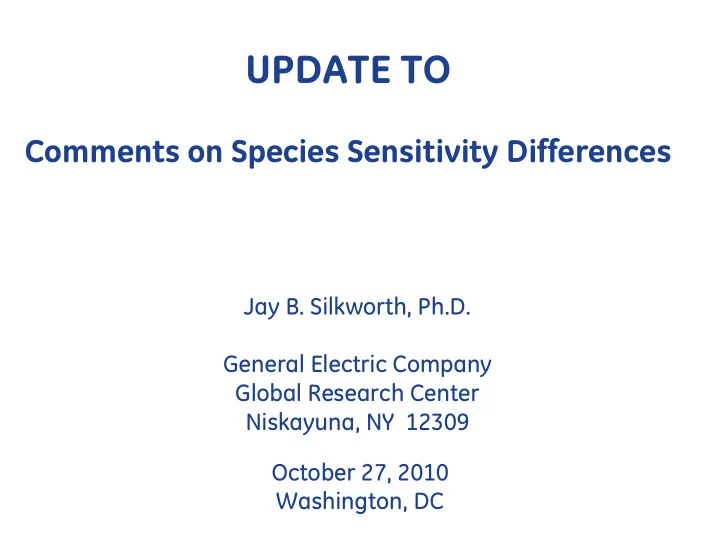

UPDATE TO Comments on Species Sensitivity Differences Jay B. Silkworth, Ph.D. General Electric Company Global Research Center Niskayuna, NY 12309 October 27, 2010 Washington, DC
Application of inconsistently derived risk values • The Draft Reanalysis uses human data to derive new RfD and CSFs for TCDD only. • To apply these values to real world mixtures of DLCs, EPA proposes to apply the current WHO TEFs which are derived from rodent studies. • But, NAS 2006 recommends ‘adjusting for species sensitivity differences’ if evidence available. • Some human in vitro derived factors are available, e.g. , PCB 126 (0.1 in rodents and rodent cells) is 0.002 in human cells. This is a growing and robust data set. 3
Hepatocytes Rhesus (3) TCDD 300 Rat (5) 250 HepG2 (5) Human cells Donors (3) 200 150 100 Human cells are 50 0 ~10x less sensitive -14 -13 -12 -11 -10 -9 -8 -7 -6 -5 -4 10 x to TCDD than Response Rhesus (3) PCB 126 300 Rat (3) rhesus and rat cells EROD 250 HepG2 (3) 200 Donors (3) to but they are 150 100 also 100x less 50 Human cells sensitive to PCB 0 -14 -13 -12 -11 -10 -9 -8 -7 -6 -5 -4 100 x 126 and Aroclor Rhesus (3) 300 Aroclor 1254 Rat (3) 250 HepG2 (3) Donors (3) 200 150 Human cells 100 50 0 -14 -13 -12 -11 -10 -9 -8 -7 -6 -5 -4 Concentration (Log M) *Adapted from Silkworth et al. (2005). Toxicol Sci. 87(2), 508-519
Human insensitivity to PCB126 is true for most responding genes Toxicogenomic REP modeling Density (Arbitrary Units) n= 79 genes 4 Human n= 47 genes Rat 3 2 1 0 0.0001 0.001 0.01 0.1 1 REP PCB126 Monte Carlo analysis of distribution around geomean REP PCB126 5
Keratinocytes TCDD Show same species Rat sensitivity differences Human REP based on EC50s is 0.0027 PCB126 not 0.1 1 Sutter et al. Tox. Sci. in press, 2010
Keratinocytes TCDD Human REP based on threshold dose is PCB126 0.0022 not 0.1 1 Sutter et al. Tox. Sci. in press, 2010
Why continue to use rodent-derived TEFs when human-derived REPS are available? TEF REP WHO TEF (Rodent based ) 0.1 Human Liver 0.002 Keratinocytes 1 EC50 0.0027 Threshold 0.0022 Lymphocytes 2 0.003 1 Sutter et al. Tox. Sci. in press, 2010 2 van Duursen, et al. , Organo Halogens, 2010
Summary • Many human genes are far less sensitive than rat genes to these chemicals. • Chemical potencies of DLCs vary across species. • Human variability is likely less than inter-species variability. • Humans genes clearly respond with nonlinear threshold- dependent dose-response curves. • Animals are not accurately predicting human responsiveness. Thank you
Recommend
More recommend